We drive the cattle through the glens, through the corries, woods and bens, through sleet or misty rain. When the moon is shining low, by frozen loch and drifted snow, stealthily and bold we go, though small our hope of gain.
Thogail nam Bo ~ “Lifting the Cattle”
The folk legend of Rob Roy MacGregor used to be a popular one in Scotland and probably still is for plenty of people across the world. In America, he is mostly remembered due to the two Hollywood movies made about his life, one of them famously starring Liam Neeson. Neither movie is perfectly accurate, but they both provide a fun adventurous romp through the Highlands, so I do suggest watching them if you want to kill some time. These movies pretty much glorify Rob which is to be expected since he is a folk hero akin to his fellow Scotsman William Wallace. However, Rob Roy also receives a certain amount of disdain and scorn from various journalists and sometimes liberal historians who are intent on painting him as a con-man, thief, and a narcissistic outlaw. This even shows up in the Liam Neeson movie, where a popular but erroneous meme is repeated that his wife was raped during their many trials and tribulations against James Graham, the Duke and Marquess of Montrose.
I decided to write this article both to glorify the real actions of this Highland chieftain and to dispel any false notions born from Hollywood films and liberal opinion pieces. To accomplish this, I will be sourcing primarily from the book “Rob Roy MacGregor: His Life and Times” by W.H. Murray, a Scots mountaineer and historian of high repute. I am also hoping that this piece will get spread far and wide, because we all need to learn how to capture the honor culture of our ancestors and act like cold-blooded killers when our lives are cast to the lot. Modern folk are weak, but Rob Roy was not - we can learn from him.
Highlands and Lowlands ~ His Times (Gaeldom vs Anglosphere)
There has long been a debate over the “Anglo vs Gael” when it concerns Scotland, leading to the “no true Scotsman” trope to be played out endlessly in America. However, by closer examination of this specific time period, and the controversy of the House of Stewart, we can better understand exactly what created this debate in the first place. When the Stewarts ascended to the throne of Scotland in 1371, it was not without great rebellion by the MacDonalds, the Lords of the Isles, along with all of their allies including the Hebridean Princes and the northern Mormaers (Earls). We should not be surprised to learn that the MacGregors (and the MacMillans) were sometimes in rebellion against the Crown, but this only goes to show much of what I will be addressing in this section. Gaels cared more for Gaeldom than anything else, and Kings were meant to serve the Folk and be married to the land, so when this didn’t happen in any fashion, great ire and wrath was summoned.
To many scholars of the time, and countless later ones, the Bruces and Stewarts were nothing more than a further shift away from Gaelic rule to a more mixed Germanic rule. The Bruces, although suitably Gaelicized, were in fact Scoto-Normans with Anglo heritage, and the following cadet-branch of their house, the Stewarts, were even more Anglo-Norman. It has been argued, and with good reason, that the last truly Gaelic King of Scotland was MacBethad, although the MacAlpins deserve to be included in my opinion owing to their great patrilineal lineage, even if they were mixing on the female line with southerners. With that said, it is clear that the Kings of Scotland were becoming less Gaelic over time, and this came to head in 1603 when the Stewarts gained the Throne of England, and therefore Wales and Ireland by default. Of course, this was highly controversial in England, and great ethno-religious wars were fought to remove the Stewarts from power at various points in their reign. This even played out in Scotland, such as Argyll’s Rising and the Bishops’ Wars, so it was not as though the Scots were always loyal to the Stewarts.
However, when Cromwell came to the scene, many Gaels stood fast to the Stewarts. Later, when the Hanovers usurped the Stewarts, it was only the Gaels who stood with them. This was particularly owing to this divide between the kingdoms and ethnicities of Great Britain, exemplified perfectly in the very mixed Stewarts. Many Gaels simply would not conceive of removing a partially Scottish king from the throne, and very few of them could consider abolishing the station of kingship. When the Stewarts were removed, it created a deep gash in the soul of the Gael, and many knew that they were bound to defend the dynasty that had originally been crown in Scotland by Gaels. Ultimately, Gaels simply viewed the situation in quite a different light. In the words of W.H. Murray:
The political aspirations of Gaeldom were not those of the Lowlands, or of the Edinburgh and London Parliaments in which the common people had no voice. Violent expression was inevitable, failing reforms in law and franchise.
These words accurately describes the situation in 17th century Scotland, for many Highlanders of those times were far more concerned with preserving their clannish way of life and bringing goods in for the whole clan, while many Lowlanders were already thoroughly ingratiated into the English system of charters and contracts and were interested in franchising far afield for individual gain. This is not an attempt to paint a picture of the noble Gael versus the ignoble Saxon - rather, this is just to juxtapose the more isolated and rural lifestyle of the Highlander compared to the more cosmopolitan lifestyle of the Lowlander and Englishman. Many of these disgruntled Gaels tried to get justice through religious and political reform, but this never worked owing to the dynamic changes between Stewart Kings and their ever-changing religious regimes. In 1688, the Glorious Revolution saw the Stewart dynasty deposed in favor for “the wee German lairdie” William of Orange, who was hated by Jacobites and immortalized in folk songs made against his character.
The new Hanover dynasty completely and permanently shifted power dynamics in Scotland and Ireland, and the Gaelic diehards were pressed to the extreme western edges of Scotland in particular. The Stewarts were not perfect monarchs by any means, but compared to William of Orange and his successors, the Stewarts were fervent Scottish patriots. The Gaelic way of life may not have flourished under their rule, but at least it wasn’t squashed and utterly subverted. In the words of W.H. Murray:
They had come out to fight for an established regime that offered no threat to Highland life, whereas the new regime would kill it. William and his Whig Parliaments at London and Edinburgh had no understanding of the Gael, and no liking. They held their way of life in contempt. The Stewarts, although anglicized, were less profoundly ignorant of their Celtic people, and deserted for the present by all save them, would if they kept the throne let Gaeldom live. Or so the clansmen trusted.
It’s not as though Rob Roy and the other Highlanders were devout servants of the Stewart kings. In actuality, they were devout patriots of Alba and the Highland way of life, with only passing regard and fealty to whichever King might happen to sit on the throne. Gaelic culture and religion was more important to them than anything else in the world, and I think if the new King William had safe-guarded and assured the clans of the survival of Gaelic culture, then many of the Highland clans would have joined him with gusto owing to old grievances against the Stewarts. The whole purpose of the Glorious Revolution was to remove the more “Celtic” Stewarts who were prone to playing the Scots and the English against each other, rather than truly favoring one over the other. It makes perfect sense why so many folks across the islands, whether they be Gael or Saxon, chafed under this disorderly dynasty of changing religions and loyalties and looked overseas for a suitable heir to the throne. For context, almost none of the Stewarts ever visited Scotland after ascending to the throne of Great Britain, and to add insult to injury, the Stewarts were prone to implanting Norman or Anglo families into Gaelic lands to subdue those uppity Highlanders. For further reference, the last folks to stand loyal with the Stewarts were largely Gaels from Ireland and western Scotland - the irony is almost palpable.
The Stewarts have their roots in a Norman-Gael family who married into the Bruce dynasty, and their rise to power came through shrewd political ploys and the military strength of Scotland. However, the Stewarts largely abandoned Scotland as their kingdom grew, for England was always more profitable and filled with better intrigue. Siding with the Stewarts in their dynastic wars was perhaps a fatal act for the Highlanders and the bloodshed and loss of land and title that followed was ultimately a degrading bloodletting that changed Gaelic culture forever. The current Hanover/Windsor dynasty has directly led to the loss of colonial lands, native culture, and now they are allowing a corrupt Parliament to destroy the very racial fabric of the islands. They have been some of the most ineffective rulers in all of Britain’s history - they almost immediately lost the American colonies after gaining the throne, for example. The slow march to destruction could have been avoided back then, three hundred years ago, when there were kings and princes with balls enough to stand on a battlefield even if they were shortsighted and poorly executed.
To compound on these issues, in the early 1700’s the Highlands experienced mass famine after a series of hard winters, which occurred in a cycle before, during, and after Rob’s life. Through astute action he was able to safeguard his family from starvation, but many Highlanders were not so lucky. Droves of hungry Highlanders poured into the fertile lowlands which helped to create the myth of the savage, poor, starving Gael. In actuality, the harsh land simply could not sustain such large farming and pastoralist populations unless the entire region was economically stable, which it rarely was during times of civil strife. Disconcerting to diehard Gaelic nationalists, the English economy actually bolstered the population of Scotland and helped create the industrial society of modernity, with all its blessings and woes. However, Scotland could not keep up because the land was unforgiving towards anything but subsistence farming, and there was much strife and turmoil mixed in with despair and depression.
Combine all of these things (regime change / civil war / economic depression / famine) and you have a recipe for disaster. This is why so many Highlanders chose to fight a losing battle with the Bonny Prince in the ‘45 - they had nothing left to lose except their lives which meant little to them. This is why so many Gaels and Anglos left Great Britain - they had nothing to keep them there except for empty charters and contracts which no longer succored them with the promised, rights, privileges, and goods. This is why Rob Roy MacGregor became so famous - he was a living fossil of the Highland way of life, stealing herds of cattle and battling against a behemoth, and he more or less came out on top of things. He responded as a true Gael should, and we must respond to our situation with the same fervor.
The majority of the Stewarts (and the following dynasties of Great Britain) were quite corrupt compared to their predecessors. Their foolish actions played an integral role in creating this modern world, especially the corrupted liberal Anglosphere. They did not appease their subject peoples and they allowed for brazen nepotism and foreign influence to cloud their thinking. In short, they made enemies of the people; as W.H. Murray explains, they reaped what they sowed:
They had learned nothing from their country’s history, which had demonstrated so clearly and often that rebels, martyrs, assassins, and guerillas are not born but made, driven to fierce ends by injustice or too prolonged cruelties. The men of government had been very busy sowing dragon’s teeth. In depriving men of spirit of the necessary modicum of human dignity, in denying them even a right of reply in defense, they debased their lives while recharging them with rage.
Sound familiar? This is why Rob Roy can serve as a role model for modern Europeans today. He fought a losing battle and came out with his life, and his legacy lives through the stories men tell of his deeds and the children he sired. We must all replicate similar deeds, if we are to leave behind anything worthwhile and wholesome. Tyrants will always seek to destroy communities - we must be the opposing force that seeks to build communities through righteous action.
Rob Roy MacGregor ~ His Life (Honor and Heroism)
~~~
The MacGregors have a sort of infamous legacy in Scotland. There are various theories concerning their origins and I will not offer my own opinion on the matter, I will just share the theories here.
The nearest thing to an official clan stance is corroborated by the historian William Skene who relates that they are descended from Griogair who ruled as co-ruler in Alba from 878 - 889 A.D.. It is sometimes said that Griogair was not a direct descendant of Kenneth MacAlpin, but was from the related royal clan known as the Cenel Loarn, who later became the House of Moray. All of the clans associated with the House of Moray (including my own clan) found themselves wrapped up in various social struggles together, and many of them were forced from their old strongholds in Moray down into the Hebrides from whence they originally came. Interestingly enough, many Highland clans associated with the Cenel Loarn ended up back in their old haunts in Dal Riata, around the Moray Firth (Lochaber, Kintyre, etc).
Some clan historians claim the MacGregors are descended from the same apostolic abbots that many Highland and Hebridean clans are descended from (such as my own) in this case they could be descended from the Abbots of Glendochart. This is due to the fact that these old Gaelic abbots were predominantly stationed in Hebridean haunts, and their abbots, monks, and priests could have families. Historians such as Somerled MacMillan maintain that the MacGregor claim to royalty is the same claim that the MacMillans and other apostolic clans make, which is not through some ancient king but rather through the deposed House of Moray who entered into the church in exile. This habit of exiling deposed nobles into the church was sometimes done by force, and other times done strategically by the nobles for their own safety. This theory also connects to the Cenel Loarn theory.
The government did not like the MacGregors, which most likely stemmed from the MacGregor’s inability to follow Lowland custom and their internecine conflicts befitting of a Highlander, along with their real claims to royalty which would’ve chafed at early Stewart rule. This was not because the MacGregors could actually claim the kingship again, but rather owing to the fact that the Hebridean clans descended from these old royal houses had incredible sway in the Hebrides and were often firm supporters of the Lords of the Isles, who were basically semi-independent rulers in their own right. In Rob’s time, the MacGregors weren’t even allowed to use their clan names and they were forced to take the names of related clans - if they did not go underground, their lives and property could be forfeit to sword and fire.
In Rob’s time, the clan system was basically disintegrating everywhere except for the Highlands and Hebrides, which held together owing to the fact that these were Gaelic strongholds and clannism is inherent to the Gael. A major component for this disintegration of the clan system was the governmental shift from the Gaelic system of having chiefs and dependents to the English system of having charters and contracts. This policy shift was put into effect after the successful “Glorious Revolution” and the words of W.H. Murray show an important angle concerning that revolution:
The Revolution was permanent; the Jacobite cause lost; the Stewarts’ claim to divine right over Church and State replaced by a people’s right to make law, appoint kings, and choose their faith. ‘The People’, of course, were still the freeholders of land valued at a minimum rent of £400 Scots, and the peers by right of rank, these two alone being eligible for Parliament or franchise.
Nobility was slowly turned into something that could be bought and sold; this was not so with Rob Roy, as shall be seen. Rob Roy MacGregor was born in 1671, third son of Donald Glas, chief of Clan Gregor, and his wife Margaret Campbell. Rob was just touching manhood when the Glorious Revolution of 1688 deposed the Stewart Kings. At 18, Rob Roy joined his father in the Jacobite Rising of 1689 led by John Graham, 1st Viscount Dundee, and Sir Ewen Cameron of Lochiel, to support the Stewart King James VII. Dundee was a true Scottish hero, remembered in poetry and song, and his deeds are often forgotten these days. Like many great Scottish generals, he died on the battlefield before his war was finished. Dundee was killed at the victorious Battle of Killiecrankie, deflating the Jacobites who then lost the Battle of Dunkeld. Donald Glas served many years of prison time after a failed cattle raid (and for being a Jacobite) and when he got out, his wife was already dead. He died shortly after release, and the rule of the clan passed to his elder son. Events transpired so that young Rob was favored by the clan and by fate, and he eventually inherited most of his father’s lands, and when all his elder brothers died untimely deaths, he inherited the chieftainship of his branch and even adopted a nephew into his household. This last action was very Indo-European, for the sons of your brothers, sisters, and siblings-in-law were to be seen as your own sons, especially those from a female line. Rob Roy showed familial loyalty and patriotic fervor at every stage of his early life.
He tried his hardest to keep his nose clean of public Jacobite affairs, but his private sympathies were well-known to all interested parties. His Highland sense of honor forced him into a line of events which exposed his true character, that of a loving husband and father, a noble patriot, and a ferocious enemy. His preference towards the Stewarts was done through necessity and practicality - there were no aristocrats who cared for Gaels, lest they be partly Gaelic themselves. His pro-monarchy stance was not uncommon amongst the Scots, however his refusal to turn against the Stewarts even in their destitute state was perhaps more uncommon. He would do this multiple times in his life, never betraying a fellow Scot even if their ancestors had betrayed his. This was the honor culture of the Gael shown true.
He was said to be stout, long-armed (incredibly so) and a passionate patriot, yet wise and cunning. Throughout his life, Rob Roy fought 22 duels, only losing his last one and due to old age - these mostly being brought on because young men wanted to test their mettle against the famous MacGregor, and they knew that if they lost he would be honorable and spare them life and limb. Rob never shrank from combat. He faced it like a man to his dying days. W.H. Murray also has this to say concerning his character, after a famous cattle-raid known as “the Hership of Kippen”:
(The Hership of) Kippen revealed an arrogant contempt for men who had certain defects he was lucky not to share - cowardice on that occasion; other illustrated in the course of his life were homosexual tendencies and corruption of good faith.
Pretty damned based, if I might say so. Cowardice, homosexuality, and corruption of good faith was sure to earn you his lasting ire, which was often deadly. Rob especially gained notoriety when he was a younger man due to a successful cattle raid on the Lowland town of Kippen. The Hership of Kippen (Cattle Raid of Kippen) brought him some pains later in life, but at that young stage he was proud that he had carried off a successful feat expected of all Highland chieftains. Cattle-raiding is an ancient Indo-European practice that was maintained among the Gaels much longer than most other folks (they even took this practice to the American Wild West!). The Cattle Raid of Cooley is perhaps the most famous cattle raid, and it holds a high place in Gaelic mythology. To liberals and cosmopolitans, cattle raiding is a sign of barbarity - to our ancestors, cattle-raiding was a fact of life. According to W.H. Murray, their justifications for this practice included:
Cattle were native to Scotland feeding on God’s pasture, no different from red deer who are also free for hunting.
Cattle-raiding had a strong cultural and spiritual quality to it, when one considers the Tain Bo Chuailgne.
For most clansmen it was excellent sport; from a chieftain’s viewpoint it gave excellent field training in hard campaign conditions, tactical planning, and the use of ground, not only for war but in the similar skills employed when driving their own cattle to distant markets.
When times were tough, weaker clans needed to raid stronger clans or else they would starve. In the words of Murray: “This practice had such real value to clan life that Gaels otherwise law-abiding viewed cattle-raiding not as theft but as a robust form of social welfare, to which everybody contributed.”
There were many laws and cultural guidelines surrounding cattle-raiding, and this system was largely seen as fair to all parties involved. Lowlanders raided the Highlands, and Highlanders raided the Lowlands. Both raided among themselves according to loyalties and need; both were seen as rebels and rogues by the other, so cattle-raiding was seen as a required business that needed laws and guidelines. Some of these laws include provisions saying you were obliged to return stolen cattle found on your land to their master, and if you were caught stealing cattle you were generally protected from mass bloodshed being visited upon you and your party, but just token blows to first blood or death with the leaders of the raiders.
Rob eventually became the legal leader of a Watch, meaning that he was hired by a large clan to protect their cattle from smaller clans and was legally allowed to carry weapons and lead armed men. This did not get in the way of his own illicit raiding, as he simply avoided those cows which fell under his protection. He became quite famous as a tracker and mountaineer due to successfully tracking down multiple stolen herds with no excess losses. The Watch was payed in a form of rent that was known at the time as “blackmail” which is the source of the later blackmail we are all so used to hearing about. Back then, it just meant a sort of protection-rent, and yes everyone had to do it or else you would risk losing your cattle in a raid. Of course, paying Rob Roy to protect your cattle didn’t just mean he would get your stolen cattle back, but that he would not steal your cattle in the first place. A good deal, and not exactly the same thing as a protection racket. Nearly everyone and their grandpa stole cattle, so just about everyone needed the Watch and paid some form of blackmail to a trusted party.
Rob began to set his sights on acquiring land, which required loans, which required more money, which required dangerous raids or successful legal transactions. Rob went with legal transactions, and he began to take out many loans from Whigs (since they had more money and worked in the areas he wanted to take advantage of). For reasons unknown, either due to an untrustworthy servant (probably this) or due to an untrustworthy debtor (as seen in Hollywood!) Rob lost payment owed on a herd of cattle. He owed the Whig Marquis of Montrose, a man he had done much successful business with in the past. Rob immediately tried to make good on his payments, but this did not matter. Montrose would utilize this debacle to attack Rob and the other Jacobites he was connected to (such as the Laird of Argyle) all of whom were economic rivals of Montrose. As W.H. Murray explains, the legal opinion concerning bankruptcy was severe:
Debtors and bankrupts at Edinburgh were treated with a harshness unconformable to a just penal code: liable to be put in the stocks and scourged… nailed by the ear to the pillory.
Furthermore, Rob was charged for carrying weapons and marshaling armed men, even though he had that legal right as a member of the Watch! Rob would never accept such a grim fate dying on the stocks. Too many MacGregors had died in the tiny little cells in the Edinburgh dungeon for him to chance the legal process. Thus began his outlaw days. He was evicted from his house and it was burned down, forcing his family to resettle in safer lands under the protection of the Duke of Argyll. Some stories claim that his wife was raped during this event, and the movie even depicts this, but W.H. Murray makes a great observation by pointing out that the Montrose probably would not have lived if Mary MacGregor had been raped by his men. Rob was that type of a guy - if someone crossed certain lines, his honor would compel him to take lethal action against them.
Rob developed a strong Jacobite reputation in the Rising of the ‘15 that it was hard to hide thereafter. He had marched with the Dundee, and remembered well the sounds of war and bagpipes. His fathers had been Jacobites, and now it was his turn to take the mantle, which he started by gathering MacGregors for the cause. Owing to the fact that he traveled across the Highlands for work, Rob served as a sort of messenger and go-between for the leading Jacobites. He famously created a public uproar when he took a band of men to a large Highland meeting of chiefs and during the wee hours of the morning he stood around an ancient Celtic cross and illegally saluted the Stewart King and announced his loyalty to the King while praying for the destruction of his enemies. This created “a rage to drink the true king’s health in public,” which was eventually seen across Scotland throughout the cold winter before the ‘15. According to W.H. Murray, Rob’s interests were purely focused on the natural clannish desire for survival:
…only by triumph of his natural prince could his own wrongs be righted, and his land restored.
So, Rob threw himself in with the Jacobites and marched under Mar’s command, even though everyone thought the man wasn’t capable on the field. Mar was capable of gathering warriors and chieftains, but he did not know how to use them. After many small skirmishes and long months of doing nothing, the Crown finally faced Mar at the famous Battle of Sherrifmuir, and even though there were clear signs of a Jacobite advantage, Mar eventually pulled away and claimed a victory that did not exist - the battle ended without a clear winner, and Mar did not press his advantage to the great dismay of the clan chieftains. Mar’s army dissipated due to his incompetence and inaction, and the rising came to nought, frustratingly enough for Rob Roy. His deeds in this rising would come to haunt him in his long feud with the Montrose. The Indemnity Act of July 1717 pardoned all those who had taken part in the Rising, but the whole of Clan Gregor, including Rob, was specifically excluded.
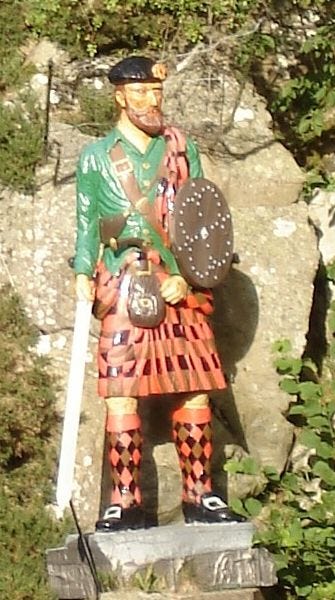
His entire clan was unable to make amends with the crown. So, the MacGregors rallied around their chieftains and Rob Roy was capable escaping imprisonment three more times while constantly raiding the lands of his enemies. Nobody could stop him, not even the dreaded Independent Companies. Thus, Rob Roy’s legend slowly began to grow, and this Highland rogue even had his name come to the ears of the King. As Murray explains: “He had open to him one other way to be rid of manhunters. Their death by ball and blade could have been easily managed. Yet despite the pressures he rejected terrorism as a deterrent. All his life long, he had this gaiety of humor, which made it impossible for him to be too intense. He chose instead to play with them as a cat with a mouse, and deter by ridicule or fright.”
He did this time and time again, from capturing Killearn to ransom him to the Montrose, to personally escaping from the Montrose and Atholl three times, to personally ambushing and defeating many government forces and robbing them of their arms. He was keen to keep his entire clan afloat through such affairs, and he slowly became a gaunt, lean, haggard man with a gleam in his eye. His family moved around the lands of Argyll, and he rarely saw them until later in his outlawery, when his enemies were at last exasperated and were forced to never again march foreign troops into the Highlands. Now, only local levies and the Independent Companies were on patrol, and they were never too eager to actually do their job at this point. Rob successfully ran circles around his pursuers, and stabbed them too many times for their liking.
The last Jacobite affair he was truly involved in was the untimely Rising of ‘19 which was spurned on by the Spanish war with England, and the landing of Spanish troops in Scotland. Rob Roy came to the summons with 40 MacGregors. The whole affair wasn’t well thought out. The Spanish garrisoned troops at some captured castles, and the Jacobite leader, a rather ineffective yet gallant Tullibardine, marched directly into a much larger British force marshaled by one Wightman. This was against the wishes of his Highland commanders, Murray, Ranald, Lochiel, MacDougall, and Rob Roy. However, the English came up the coast and burned the Spanish fleet and garrisons out, and the Highlanders truly had little choice at this point. The ensuing battle was situated around a hill that was later renamed “Sgurr nan Spainteach” in honor of the Spanish who fell there fighting with the Scots. The battle started with a barrage of mortars by the English against the Scottish hill. Then three waves up the hill which were repulsed. During the last one, exploding grenades caught the heather on fire, and in this confusion many of the leaders were injured during repositioning, and thus a general retreat was sounded. Despite the legends, Rob was not wounded, but in fact saved the injured Seaforth as they retreated up the mountain.
He escaped with his life, and now the Jacobite Cause would have to wait for the Bonnie Prince to come of age and lead the Highlanders. He was now getting old. Many of his old allies were even older, or dead, and the ones left were begging him to make amends. So, he did, and he was able to take solace knowing that many Highland chieftains were at his back, making false amends to a Crown they were soon to rise against once more. Over the ensuing years, he did little more to make his name great, but he did fight in a clan battle over a little debate about land ownership of Invernenty, and since both clans were Jacobites, and Rob was old, he found a way to make amends. This included an honor duel against Rob himself, and it was the only one that his lost, but even his young opponent admitted it was due to Rob’s age.
He began to settle into his regular life as a chieftain of his clan, and father to his sons, and husband to his goodly wife, Mary. This came easier when the famous author Daniel Defoe published “Highland Rogue” which made Rob Roy incredibly popular and feared across the island, and many great men dared not cross him, and many small men sought his favor. His name was even known to the Hanover King, who once wished to see the Highland Rogue, although Rob did not have faith in the King’s trust. Rob continued to serve his clan, but with new gusto, because now he was secure after his long affairs. He had successfully come out clean. With his feud ended, Rob was able to quietly retire into the life of an old Jacobite Highland chieftain, and he really didn’t do very much beyond from buying and selling cattle, attending to clannish affairs, and assisting Jacobites in their shared cause. Rob eventually died at the age of 63, a free man living in the lands of his ancestors. His final act was to make peace with MacLaren of Invernenty. At this point he was bed ridden, but for the meeting he asked to be sat in his chair in his great kilt, with dirk and pistol with him. After the meeting, he laid down for the last time. It’s said that his last words were: “It is all over. Put me to bed. Call the piper. Let him play Cha till me tuille.”
Rob Roy MacGregor’s life story is one of clannish loyalty, piety, honor, courage, and patriotism. This is a man worth emulating, especially in such trying times.
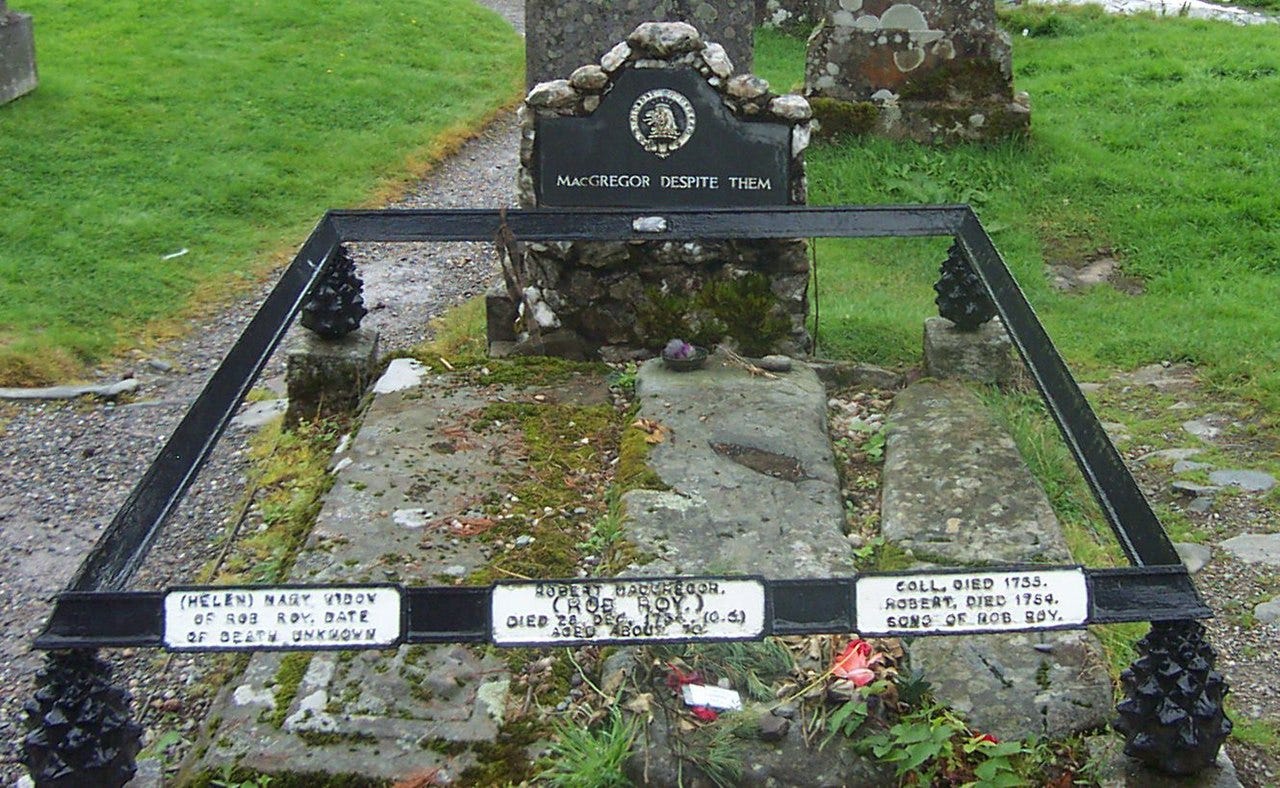
Hail the MacGregors! Hail victory! Thank you, and good-end! o///





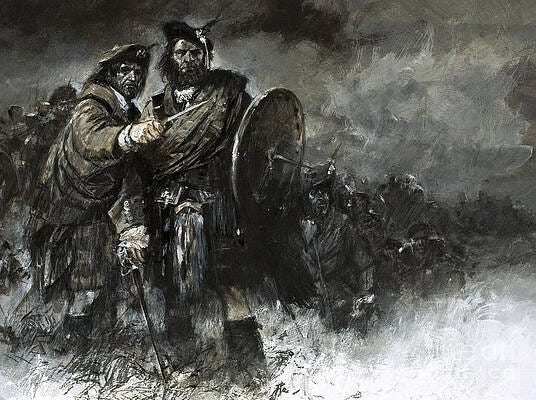

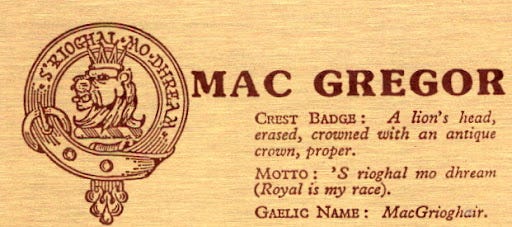
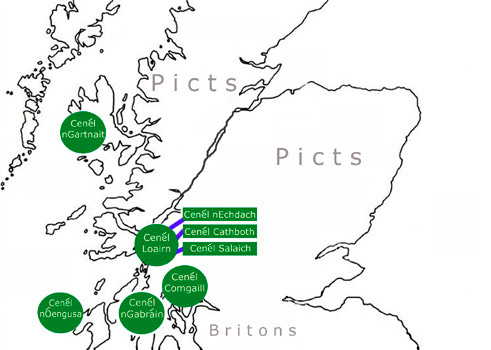
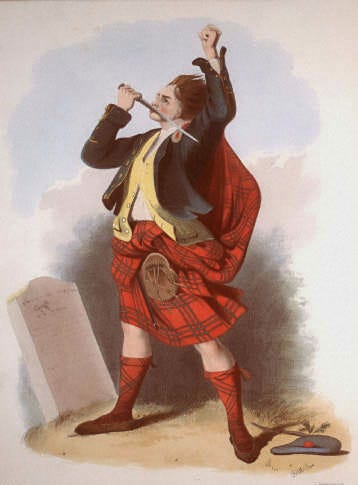
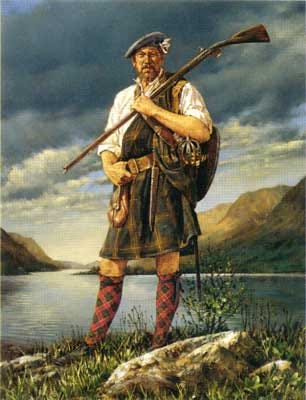
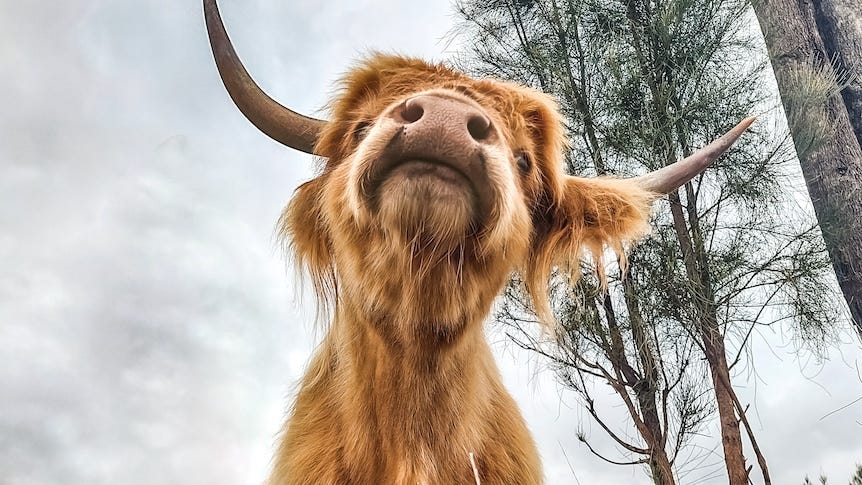

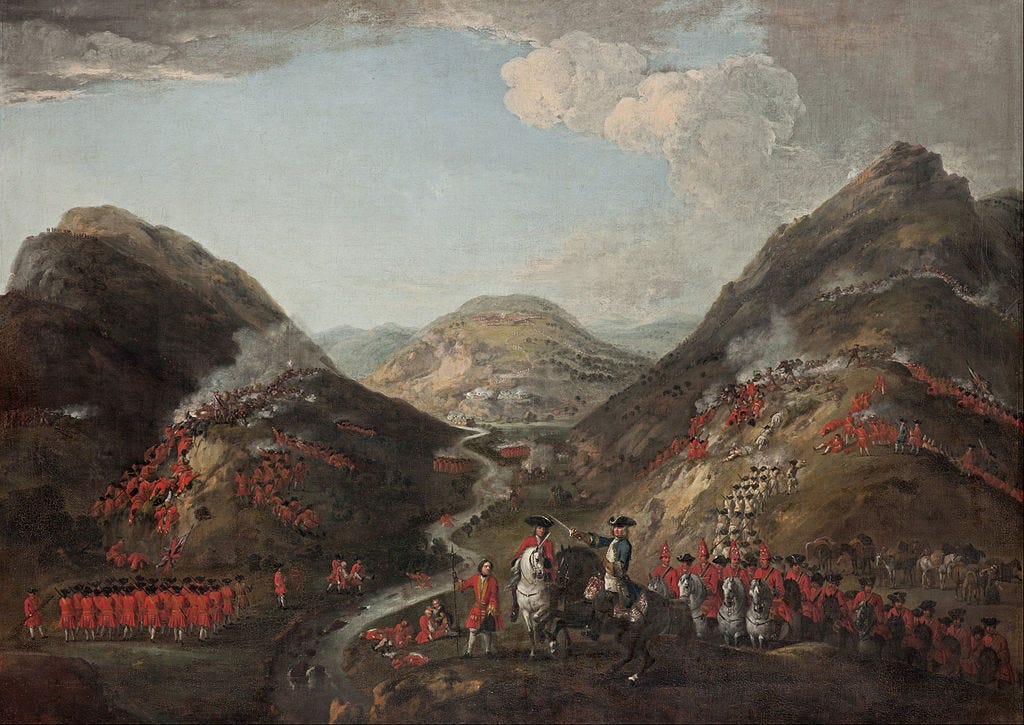
Brilliant article.
Excellent article 👍 I particularly found the part about cattle-raiding interesting and it reminded me of a few chapters in the book Lonesome Dove, though they don’t steal cattle, but horses, however, you get the similarity. o7 🤍 and take care. ✌🏻
Here’s the book Lonesome Dove by Larry McMurtry: https://www.amazon.com/Lonesome-Dove-Novel-Larry-McMurtry/dp/1439195269/ref=sr_1_1?crid=22T72B8AVBQ9B&dib=eyJ2IjoiMSJ9.wdkxRkz_Z__1hj6YpcPWVpZniVNgGeRyZzoW6zxGnf4CuQr7En7g3bzOrzhsOjIgOGnw8if_wlvF5fzSGA62QkFT4V-VSweL2N4s9Kf8_16_zIoje83mst7Z9wmhu859T2bTcwbs9pvDuNOhS9mKBn5RQPxkd1uzlIUVjr7yCuV-3HG1d7TyFHfF5kclMli59_m00TME_FLVX1CHv291CC7v7nZLuYlGib9VWDiB1Qk.v0OFHlx-y9GbslJRCVXfMgwmsFFm-s1wZHtbg8cAuLA&dib_tag=se&keywords=lonesome+dove&qid=1747188589&sprefix=Lones%2Caps%2C122&sr=8-1